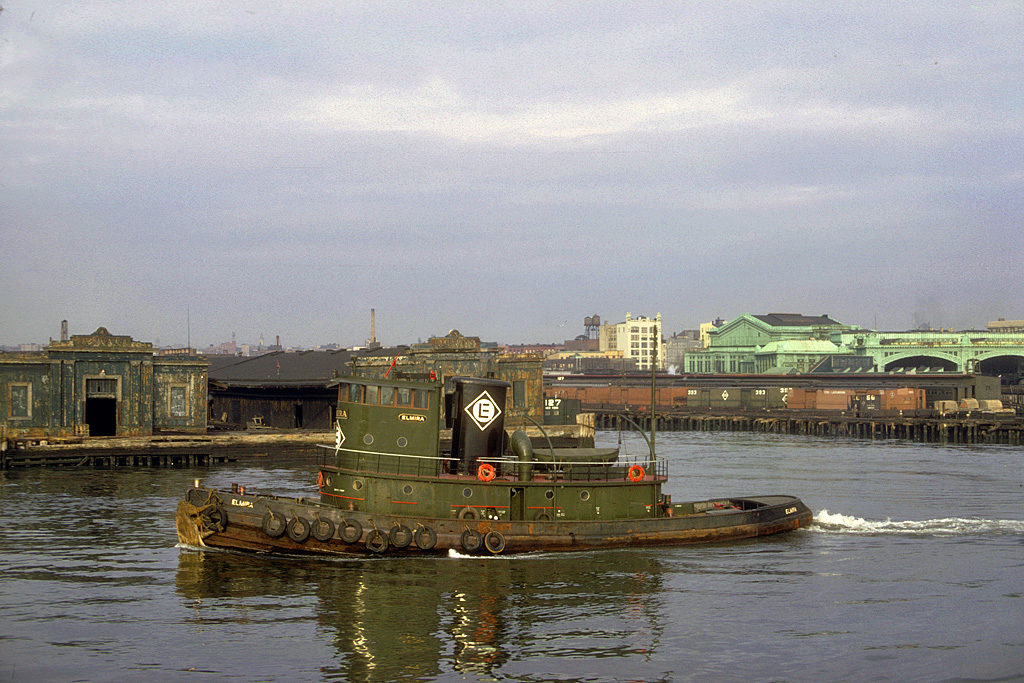
The ex-Erie tug Elmira passes by the slips at Hoboken. The EL Terminal is seen on the right, with express cars in the tracks. The well worn face of the waterfront buildings shows in the soft morning light.
Comments:
Note the old covered barges in the right background; one of them still carries its original "Erie" diamond. Back in the 60's, there would be a wide variety of passenger stock sitting on the rails of the old pier that can just be seen on the far right (an ex-Erie Stillwell can just be glimpsed). A lot of through cars could be seen there also; there was also a small machine shop located on that pier.
Into the 80's, CR and, later, NJT, stored all sorts of bad order equipment out there. I still remember an old box car that was full of nothing but old, decaying rattan seat cushions, salvaged from scrapped commuter cars. Equipment was no longer stored there after the pier, in part, was converted for use as a pedestrian approach to the waterway ferries, that began operation in 1989.
The old DL&W lighterage piers seen here perished in a spectacular fire in the late 70's; I well remember the thick black smoke that covered the area on that windy day. I also remember taking a few snaps of the twisted, warped steel framework of these piers, a number of years after the fire.
I have many pleasant memories, especially from the early and mid-60's, of mom and I eating lunch on the bulkhead alongside the docked tugs. Like the ferries, I knew all their names, and remember being surprised that one tug (the "Binghamton") shared the same name with one of the ex-DL&W ferries. Likewise, of course, the "Elmira", pictured here.
What was left of E-L's float/lighterage operations continued to dwindle until Conrail eliminated all remaining E-L (and LV) marine operations in 1976. Adjacent to the passenger terminal (south side) near where the tugs would dock, and half-sunken, wooden DL&W "stick lighter" sat on the mud into the 1980's, when it was finally removed.
Still so much of the past remained in 1967, although, even then, much of it was already living in borrowed time. (Thanks for the excellent recollections John. -webmaster)
Into the 80's, CR and, later, NJT, stored all sorts of bad order equipment out there. I still remember an old box car that was full of nothing but old, decaying rattan seat cushions, salvaged from scrapped commuter cars. Equipment was no longer stored there after the pier, in part, was converted for use as a pedestrian approach to the waterway ferries, that began operation in 1989.
The old DL&W lighterage piers seen here perished in a spectacular fire in the late 70's; I well remember the thick black smoke that covered the area on that windy day. I also remember taking a few snaps of the twisted, warped steel framework of these piers, a number of years after the fire.
I have many pleasant memories, especially from the early and mid-60's, of mom and I eating lunch on the bulkhead alongside the docked tugs. Like the ferries, I knew all their names, and remember being surprised that one tug (the "Binghamton") shared the same name with one of the ex-DL&W ferries. Likewise, of course, the "Elmira", pictured here.
What was left of E-L's float/lighterage operations continued to dwindle until Conrail eliminated all remaining E-L (and LV) marine operations in 1976. Adjacent to the passenger terminal (south side) near where the tugs would dock, and half-sunken, wooden DL&W "stick lighter" sat on the mud into the 1980's, when it was finally removed.
Still so much of the past remained in 1967, although, even then, much of it was already living in borrowed time. (Thanks for the excellent recollections John. -webmaster)